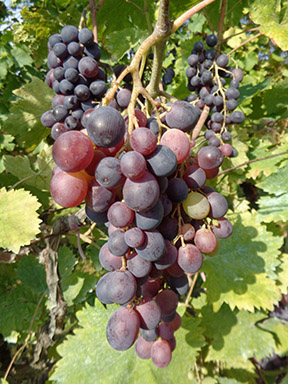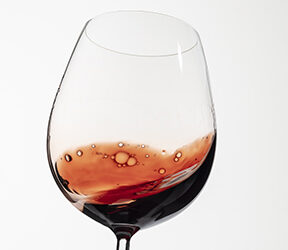Black Muscat is a unique variety within the gigantic family of Muscat grapes. But black sheep it is not! This thinner-skinned, white-fleshed grape has its family’s incredible aromatic character with unique color and flavor properties that make it a special variety to create memorable wines. Muscat is the largest family of grapes and are thought to be some of the original genetic species of grapes from which all other grape species evolved. The Black Muscat variety is also known as Muscat of Hamburg, Black Hamburg, or Muscat Hamburg. It is grown all over the world, including Eastern Europe, France, England, Greece, China, Australia, and throughout the continental United States. It is even the grapevine that is grown at the world’s most southern point, with a small number of vines being grown at the conservatory at the Government House in the Falkland Islands.
A Little History

The Black Muscat grape is a cross breed of two other varieties: Schiava Grossa and Muscat of Alexandria. It was first crossbred in 1850 in Bedfordshire U.K. by Seward Snow, the head gardener to the Earl de Grey in Wrest Park. The aromatic new variety quickly gained popularity in France. Large quantities were planted on the slopes of Mont Ventoux, which lies between the Alps and the Mediterranean Sea. Mont Ventoux has large holdings of limestone within its geological makeup, which are partly responsible for the excellent soil that is generated on its slopes, conducive for grape growing. The overall resulting soil composition of this area is sedimentary limestone mixed with clay. Black Muscat grapes are grown on the mountain slopes at about 200 meters of elevation. The crop flourished here to such an extent that the French government bestowed upon Black Muscat an AOC, appellation d’origin contrôlée, which designates and protects a certain regional variety of grapes and heavily controls their cultivation standards. Within the Muscat de Ventoux criterion, Black Muscat grapes from this area must be harvested within a certain time period, fulfill certain color and size quantifications, and be hand harvested with scissors. The extreme regulation and care that is applied to the harvest of these grapes is clear evidence of the high-quality wines they can produce. The Mont Ventoux region currently has about 250 producers within its geographic limits, producing 4–5.3 tons per acre (10–13 tons per hectare). When the grapes are harvested, two sets of picking bins are brought into the vineyard. Those grapes that fulfill the AOC requirements are placed into one bin and sold at a premium, and the grapes that do not satisfy the requirements are placed into another bin and either sold at a lower price or used to make the “house wine.”
Black Muscat is also praised for its unique winemaking characters outside of France. It has found a niche market in American and Australian viticulture in the making of dessert wines. It belongs to a group of dessert wine Muscats that viticulturists refer to as “liqueur Muscats.” These sweet, dessert-style wines are seeing a surge in popularity worldwide. Black Muscat is one of the varieties in the group along with Muscat of Alexandria, Muscat Ottonel, Muscat Rouge, and Muscat Blanc. The grapes can either be blended or fermented separately, which is the method used for higher-end productions. Black Muscat created in this fortified dessert wine style starts with allowing the grapes to hang on the vine longer to raise Brix levels. Then the grapes are harvested and allowed to raisin slightly, further concentrating the sugars. The grapes are then fermented, with the high Brix levels eventually eclipsing the yeasts’ ability to ferment due to such high alcohol concentrations. Or the fermentations may also be arrested with the addition of brandy.
Black Muscat has found a home in American winemaking, specifically in California. I spoke with Frank Musto, a seasoned California grape supplier, who owns contracts on vineyards of Black Muscat, to ask about the appeal of this grape variety.
“Black Muscat, though often overlooked by home winemakers, holds a revered status in Californian wineries. Renowned for its floral notes, fruity essence, and reminiscent of the classic Muscat taste profile, it predominantly finds its place in crafting decadent dessert wines and delicate rosés. Across the country on the East Coast, it emerges as a premier grape for producing grappa and essence-flavored spirits, captivating palates with its rich flavor and bountiful clusters.”
Rosés and Beyond
In addition to dessert wines, Black Muscat is also seeing a rise in popularity due to its rosé potential. Rosé-style wines have been a rising trend in American wine consumption for the past five or so years, and this variety creates a unique rosé wine with interesting flavors and characters. Christina Musto, experienced Winemaker of Musto Wine Grape Co., has worked extensively with the variety and created multiple vintages of the rosé. “On the nose there is passion fruit, guava, sweet strawberry, sweet cherry, and papaya. The aromatics continue through the palate with a touch of crisp acidity. As a dry wine, this light-bodied rosé is full of complexity and flavor. If you’re more of a sweet wine drinker, adding about 1–2% residual sugar to this wine would make for a very aromatic and balanced sweet wine. Or you can go full-on dessert wine, which a lot of people do and love it!”
Christina was gracious enough to share with me her recipe for a rosé of Black Muscat, which I have given details for in the recipe that follows.
A key factor when fermenting Black Muscat is keeping the temperatures down. Grapes within the Muscat family are prized for their complex and delicate aromas, which can easily be lost in a hot fermentation. A rosé of Black Muscat can easily showcase aromas of cotton candy, raspberry, passion fruit, sweet strawberry, and watermelon. But if the fermentation stays consistently above 70 °F (21 °C), some of the complexity of the aroma may be lost. A skin contact time of at least six hours is recommended to retain some of the beautiful light pink color. An extended maceration time on the skins may secure more color and more aromatic potential, but I wouldn’t suggest going over 36 hours with the skins, which would risk the absorption of harsher tannic phenolics that could alter the delicate character of a rosé.
If making Black Muscat in a red wine style, extended maceration and fermentations on the skins will yield a deeply pigmented garnet-colored wine with intense aromatics of roses, cherries, and strawberries. This wine is light- to medium-bodied with lighter tannin content due to the thinner skin of the grape. It is often backsweetened and served chilled as a dessert wine or aperitivo. It is excellent with pungent cheese such as Gorgonzola or goat cheese, as well as fruity or dark chocolate desserts. It can also be added to sparkling wine to make a Kir-styled cocktail.
When fermenting Black Muscat in either a rosé or a red style, I recommend incorporating a glutathione addition into your winemaking additive list. Glutathione is a molecule comprised of three amino acids: Glutamate, cysteine, and glycine. They occur naturally in grapes and within wine yeast. Glutathione helps to protect the delicate aromas within aromatic wines by scavenging quinones, which are compounds responsible for the browning and aroma loss associated with oxidation reactions. By attaching and binding to quinones, the glutathione will protect and preserve the aromatic compounds throughout the fermentation and aging process, saving the delicate aromas for the winemaker to enjoy. If yeast does not have adequate nutrition throughout their metabolic cycle they can consume glutathione, which contains nitrogen, for basic nutrition. This will deplete natural reserves of glutathione from the grapes or yeast, leaving the aroma compounds less protected against oxidation. Glutathione can be added via the addition of products such as Opti-White and Booster Blanc but should also be added with a yeast nutrient to protect against their consumption by the yeast. Research conducted by Lallemand Laboratories shows that the addition of glutathione at the beginning of alcoholic fermentation will help preserve delicate thiols not only during fermentation, but throughout the aging process, making for a long-lasting aroma.
Black Muscat can be made in a wide variety of styles, but in my opinion, there is no better fit for the grape than turning it into a rosé. If you have a white variety that is a bit lackluster, Black Muscat can be pressed off the skins and fermented as a white wine and could provide the rich floral aromatics and fruit notes that could perk up an otherwise lacking white wine. Any way you’d like to ferment it, Black Muscat will present you with a bouquet of flowers and fresh berries — always a welcomed addition to my table.
Black Muscat Rosé Recipe (5 gallons/19 L)
Ingredients
108 lbs. (49 kg) Black Muscat grapes (three 36-lb./16 kg boxes)
Potassium metabisulfite (KMBS)
Citric acid
5 g yeast (Vin13, 58W3, Alchemy 1, BA11, or QA23)
7.5 g Go-Ferm Sterol Flash
7.5 g Fermaid O
5 g Fermaid K
5 g Opti-White
5 g Booster Blanc
5 g Bentonite
Distilled water
Table sugar (if Brix is low)
Potassium sorbate
Zenith Uno or Celstab (optional but helpful)
Equipment
Crusher/destemmer
Wine press
15-gallon (57-L) fermenter
5-gallon (19-L) carboy
Airlock and bung
Auto-siphon and tubing
Stir paddle
Spray bottle
pH meter
Hydrometer
Spoon and small mixing bowl
Thermometer (digital preferred)
Sanitizing solution of KMBS
Glass marbles (optional)
Step by step
1. Ensure all of your equipment is clean and in proper working order. Make a fresh batch of KMBS sanitizing solution using 1 Tbsp. of KMBS powder and 1 Tbsp. of citric acid mixed into 1 gallon (3.8 L) of clean water. Fill a spray bottle with the solution and spray down your processing equipment but ensure there is no pooling of sanitizer in bins or press basins.
2. Crush and destem the grapes into a food-safe bin to begin their maceration period. Add 50 ppm of KMBS, dissolved into water, into the must and stir well. Allow to sit for 6–24 hours depending on how dark you would like your juice to be. Remember, it will lighten up considerably throughout fermentation.
3. Press off the juice from the must after the maceration period. Ensure the press is sanitized and no sanitizing solution is pooling in the bottom of the press or in the transfer hosing.
4. Transfer juice into sanitized fermentation bucket.
5. Take measurements of your juice, including volume, Brix, pH, and titratable acidity (TA). Adjust the juice to have a starting Brix of at least 22, a pH of ~3.3, and TA of 8– 9 g/L.
6. To prepare the yeast, warm up 50 mL of distilled water to 60 °F (16 °C) and add to the mixing bowl. Then add the Go-Ferm Sterol Flash and stir well. Add 5 grams of yeast and stir well. Allow to sit for 15 minutes. Then mix in thoroughly to the juice with a sanitized stir paddle.
7. Mix both the Opti-White and Booster Blanc with a small amount of distilled water to create a slurry and then stir into the juice. Mix well.
8. Place a lid loosely on the fermenter and wait 24 hours to observe yeast activity. Take Brix measurements twice daily via a hydrometer to ensure the start of fermentation. Using the thermometer, take temperature measurements daily. Try to keep the fermentation temperatures as close to 60 °F (16 °C) as possible to preserve the aromatic compounds. To do this, you may need to put the fermentation
bin in a cool area of your basement, outdoor porch, refrigerator, or in a larger bin (garbage pail) filled with
ice water.
9. After one or two days of fermentation, check the Brix and if it has dropped by one or two degrees, it will be time to add some nutrients. Add 100 mL of distilled water to a mixing bowl and add 7.5 g Fermaid O. Mix well to create a slurry and then stir into the fermenting juice.
10. Continue to monitor Brix and temperature daily (twice daily would be preferred). When the Brix has declined to between 15–11 °Brix, add the Fermaid K in the same way you added the Fermaid O.
11. Continue to ferment as close to 60 °F (16 °C) as possible until the wine ferments dry (about -1 to -2 °Brix). This should take between 7–21 days.
12. Rack off the gross lees into a sanitized carboy. Add 50 ppm of KMBS and stir well into the wine. Affix the bung and airlock and allow to sit for 5–7 days.
13. Rack off the lees into a clean, sanitized carboy. Affix bung and airlock and allow to sit for a month. If you have an air gap after racking, either top up with a complementary wine such as Riesling or Muscat or add sanitized glass marbles to displace the headspace.
14. When the wine is one month old, rack again into a sanitized carboy and add another 50 ppm of KMBS. At this point, the wine should give off minimal lees and should be hazy but not opaque. Consider fining with bentonite to help clarify and help with heat stabilization. Mix bentonite according to its directions (every formulation may have its own unique preparation). Add to wine and allow to settle 2–3 weeks. Once settled, rack the wine off the lees into a clean and sanitized carboy.
15. Allow the wine to sit and age, maintaining a free SO2 level appropriate for the pH. WineMaker’s sulfite calculator (www.winemakermag.com/sulfitecalculator) will help you determine the proper dosage given the parameters of pH and volume. You may want to consider cold stabilizing or acquiring a cold stabilizing product such as Zenith Uno or Celstab. These products may only be used if the wine is filtered down to 0.5 micron as turbidity will interfere with their effectiveness. If filtration is not available, try to cold stabilize via exposure to cold (put wine in a plastic container, do not try to cold stabilize in a glass carboy).
16. Once cold stabilized, taste to see if you desire some sweetness to balance. If you would like to backsweeten, raise the free SO2 to 50 ppm and add 1 g/gallon (3.8 L) of potassium sorbate. Stir well, then add whatever amount of sweetener you would like to achieve the desired result. (Conducting bench trials to determine this amount is highly recommended!)
17. Bottle wine once you are content with the flavor and stability of the wine. Always add a small amount of sulfite before bottling — 10 ppm beyond the sulfite calculator’s recommended value to account for oxygen uptake during the bottling process.







